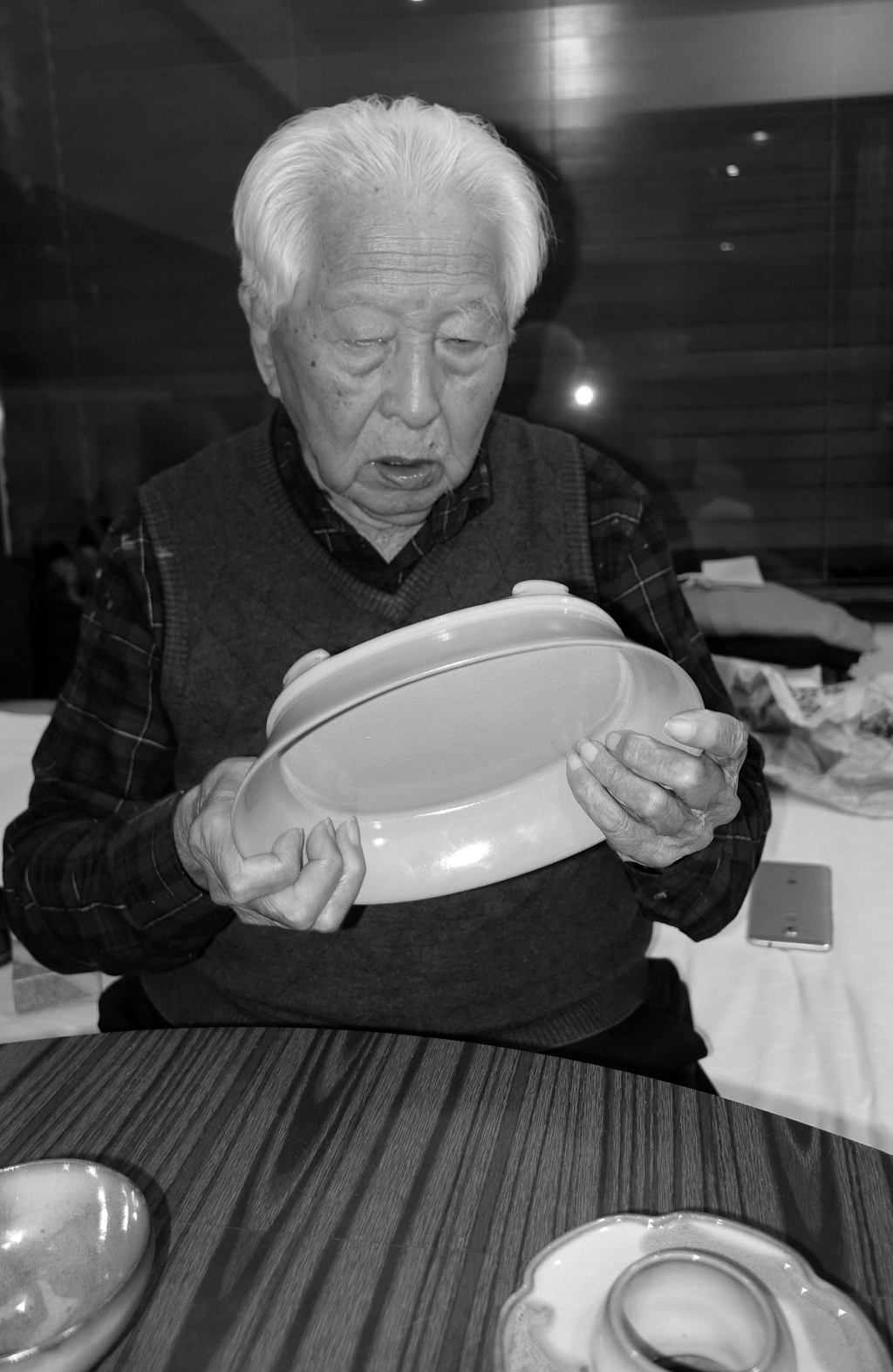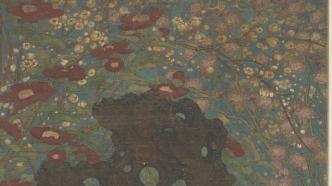
Today is the first day of the Lunar New Year, "the first day of the first month is the dynasty of the year". At this time, the yuan will start again, and Vientiane will be renewed. Since the Song Dynasty, painters of all dynasties have loved to make pictures of the year and the Qing Dynasty. All things auspicious meaning.
The ancient poems have "fold a spring and put it in a bottle". "Qinggong", also known as "Qingwan", was originally the offerings such as flowers and fruits offered by the ancients during traditional festivals or worshiping Buddha, and later developed into various elegant objects placed in the home of poetry, books, rituals and music. Is it the magnificence of "Sui Chao Tu" written by Zhao Chang in Song Dynasty, or the quaint fragrance of "Sui Chao Tu" by Chen Hongshou in Ming Dynasty, or the self-entertainment of Wu Changshuo's "Sui Chao Qing Gong Tu", which presents seasonal elegant flowers, elegant Playing utensils and other mascots related to the Sui Dynasty. The "Palace Flower Letter" column of "Paper News·Ancient Art" presents the collections of the Palace Museum and the National Palace Museum in Taipei. I wish readers and friends good luck and elegance.
Song Zhaochang Sui Dynasty Chart Axis

Song Zhaochang Sui Dynasty Picture Axis Collection of the National Palace Museum, Taipei
Although Zhao Chang's famous inscription "Chenchang" is on the "Sui Dynasty Picture", it is not like the Song Dynasty style in terms of brush and ink painting style and moss, rock slope and grass. Emperor Qianlong on Shitang wrote: "The cover painting is large, or there are damaged parts, which are cut off by Yongjia, and don't sign forged money. The preservation is not complete." Judging from the unnatural cutting of the edge of the painting , when this possibility exists. The plum blossoms, camellias, narcissus and periwinkle in the picture are painted with cinnabar, white powder, rouge, and stone green, and then filled with azurite. The colors are bright and magnificent. Its composition is special, with lake stones and densely interlaced flowers covering the entire picture without leaving any space, neat and serious, and has a very decorative effect. It is mentioned in Song Guo Ruoxu's "Pictures and Experiences" that there were paintings called "Pudianhua" in the court of the Southern Tang Dynasty. They were used for hanging in the palace, and they must be placed in a dignified place. The composition of this work is consistent with the natural state, and it can be used as a representative of the continuation of this style.
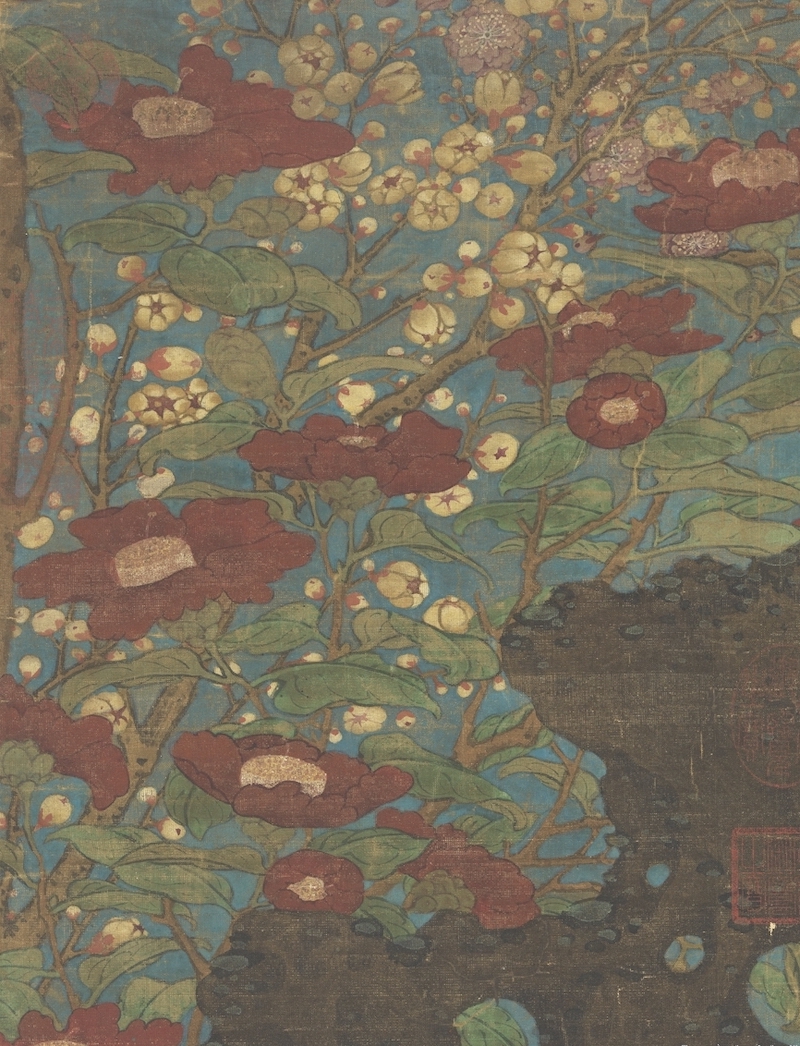
Axis of Song Zhaochang's Sui Dynasty (partial) Collection of National Palace Museum, Taipei
Zhao Chang (about the end of the 10th century to the beginning of the 11th century), courtesy name Changzhi, was born in Chengdu, Sichuan. He is good at painting flowers and fruits. He often walks around the fence to watch flowers and draw them immediately in the morning dew, so he calls himself "Sketch Zhao Chang". However, there are very few works handed down from generation to generation, so it is difficult to confirm his painting style.
Southern Song Dynasty Li Song "Flower Basket Picture"
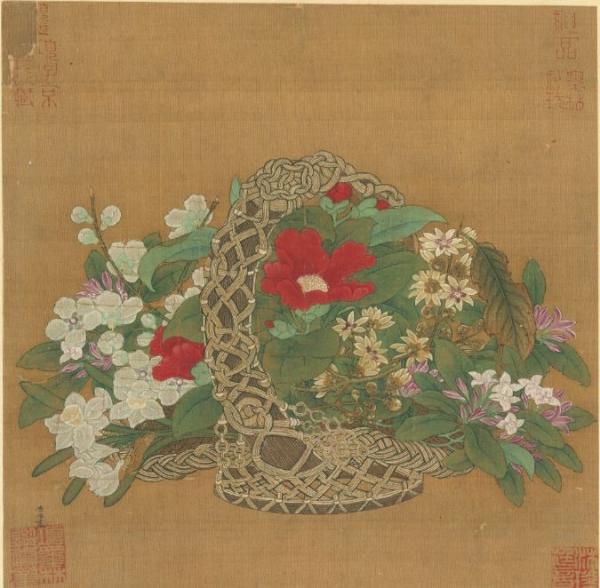
"Flower Basket Picture" (winter flower volume) is now in the National Palace Museum, Taipei
The "Flower Basket Picture" by Li Song (1166-1243) of the Southern Song Dynasty in the National Palace Museum in Taipei can be regarded as a representative painting of "appreciating flowers at the age" in the Song Dynasty.
"Flower Basket Picture" (winter flower volume) is now in the National Palace Museum, Taipei. The rattan baskets are full of early spring flowers, including red camellia, green calyx plum, narcissus, wintersweet and daphne. Among them, camellia is the main flower, and green calyx plum is a famous product in the court, such as Chen's (1214-1297) "Green Calyx Plum Song": "If you don't see Xuanhe Genyue green calyx plum, this is the first among the hundred flowers."
"Flower Basket Picture" (Summer Flower Book) is now in the Palace Museum in Beijing. In the basket, there are hollyhocks in full bloom as the main flower, and day lilies, gardenias, pomegranates and other summer flowers as supplements. The colors are bright and well arranged. The bamboo basket The weaving is exquisite, reflecting the fashion of flower arrangement in the Song Dynasty.
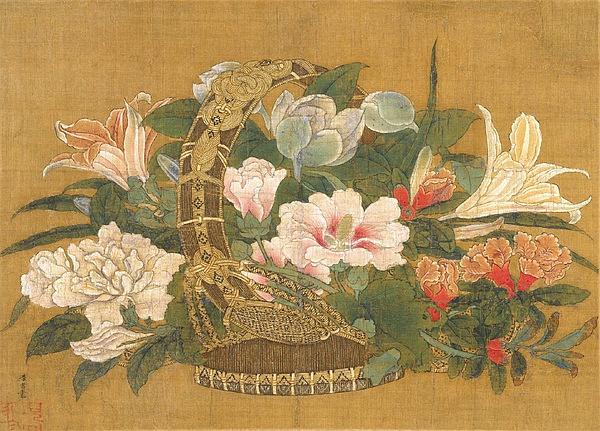
"Flower Basket Picture" (Summer Flower Book) is now in the Palace Museum, Beijing
Although the painting of "Flower Basket" is not large, its depiction is delicate and specific, its modeling skills are profound, its lines are delicate and powerful, full of changes, its colors are gorgeous and elegant, and its composition is stable and full, which is enough to prove Li Pu's profound painting skills. The exquisitely woven bamboo baskets and the superb flower arrangement skills illustrate people's love for the art of flower arrangement at that time, and also show the prosperity of flower and bird paintings in the court of the Song Dynasty.
Axis of the Years and Dynasties of the Song Dynasty

Scroll of Years and Dynasties in the Song Dynasty Collection of the National Palace Museum, Taipei
Hanshu Wuxingzhi: "The first day of the first month is the three dynasties." Tang Yanshigu's note: "The first day of the first month is the dynasty of the year." Sui Dynasty refers to the beginning of the first year. At this time, one yuan starts again and Vientiane is renewed. The painters of the past dynasties made Sui Dynasty pictures, which contain the meaning of starting the pen on New Year's Day and wishing everything auspicious in the year.

Axis of the Years and Dynasties of the Song Dynasty (partial) Collection of the National Palace Museum, Taipei
This painting depicts springs and stones facing the stream, a pair of pheasants, a few sparrows, camellias grow behind dried plums, and green bamboo grows above the backflow. Daffodils, white plums, and black tea are in full bloom at the top and bottom respectively, with vermilion and white tones contrasting each other. Lu Zonggui's "Chun Shao Ming Xi" in the courtyard has the same layout structure as this one.
Song Dongxiang Sui Dynasty Chart Axis

Axis of Song Dongxiang's Years and Years Collection of the National Palace Museum, Taipei
Dong Xiang in the Northern Song Dynasty was born in Kaifeng, Henan Province. He was an imperial edict for the Hanlin Academy of Painting. He painted ink, flowers and bamboo with a naive taste, and later generations often learned from him. This painting has a lot of suspense, but it is not enough to do its best.
Axis of Years and Dynasties of Yuan Dynasty
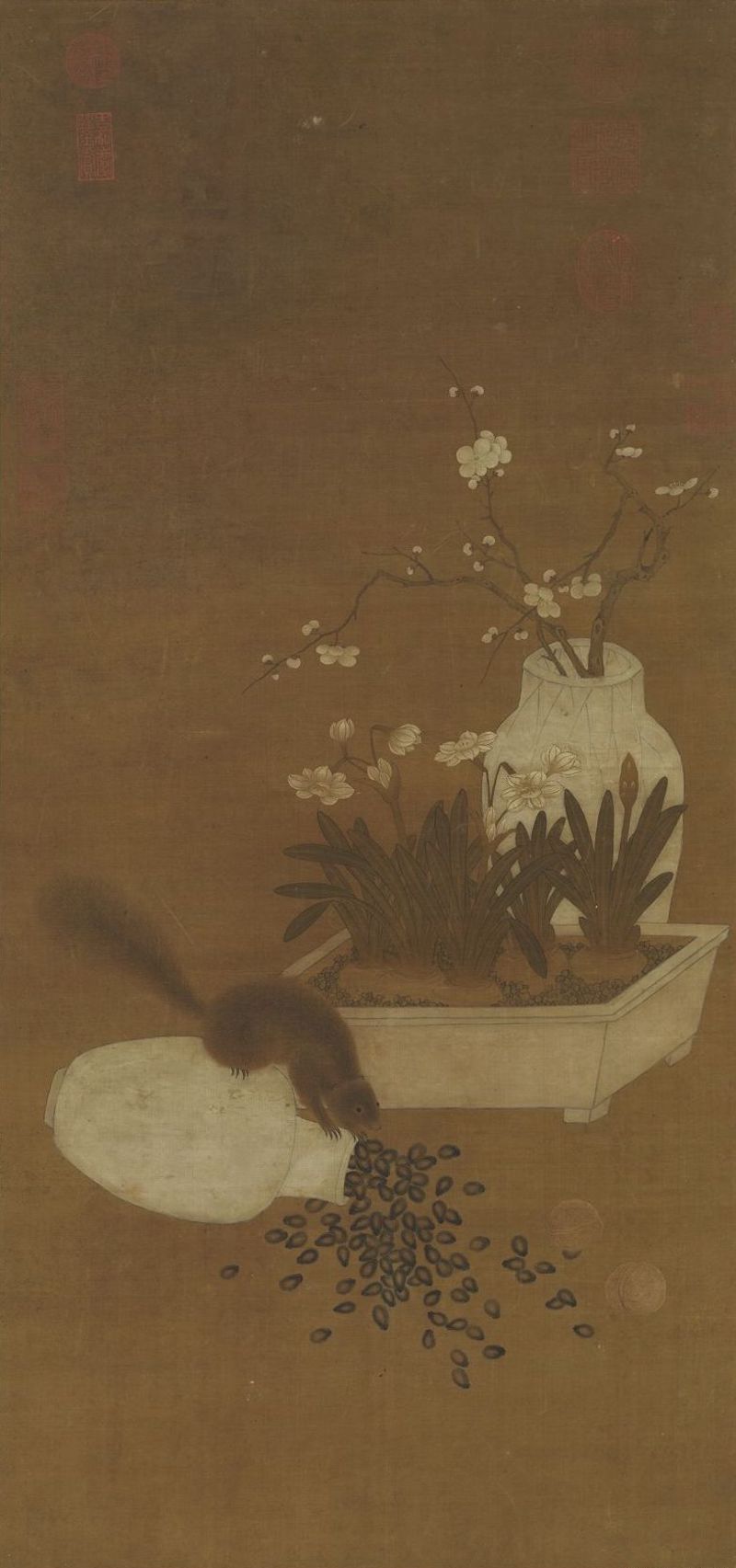
Axis of Years and Dynasties of the Yuan Dynasty, Taipei National Palace Museum Collection
Ice-cracked vase decorated with broken branches of white plums and potted narcissus in the front. This axis is provided for Sui Chaoqing, and the blessings of the flower fairies during the Spring Festival symbolize the happiness of the new year. There is also a squirrel playing in a bottle, eating melon seeds and walnuts scattered on the ground, adding to the lively and lively atmosphere of the picture. The melon seeds and peach pits in the picture also have the auspicious meaning of "harmony of descendants".
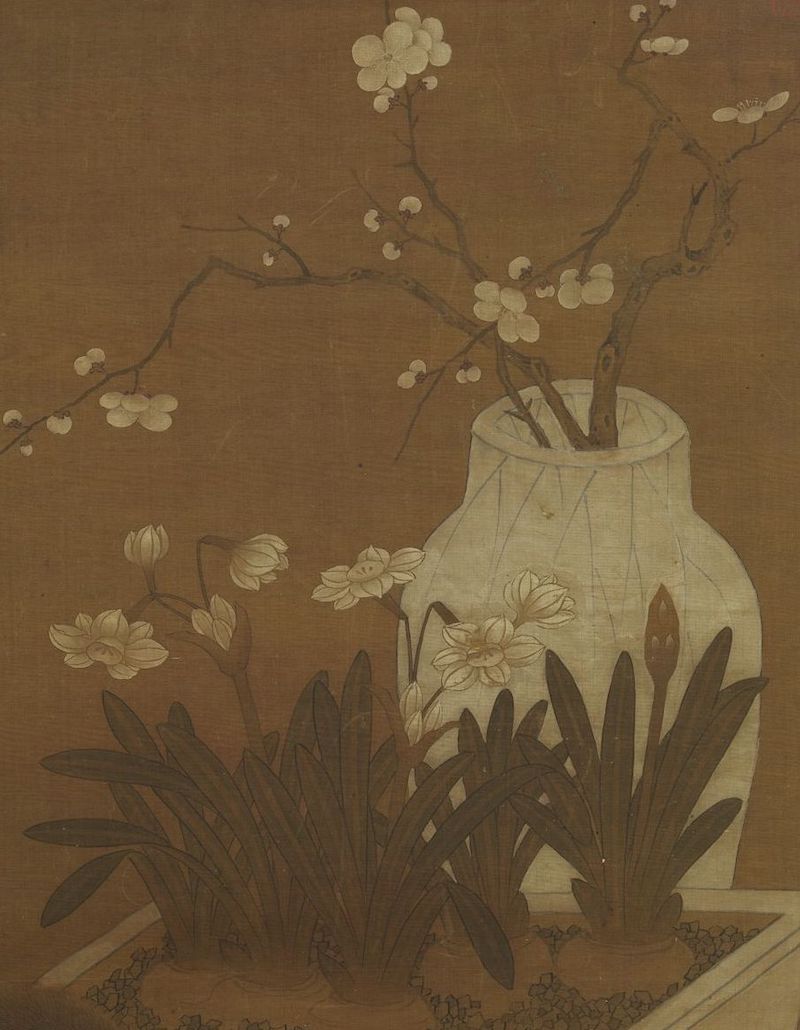
Axis of Years and Dynasties of the Yuan Dynasty (partial) Collection of the National Palace Museum, Taipei
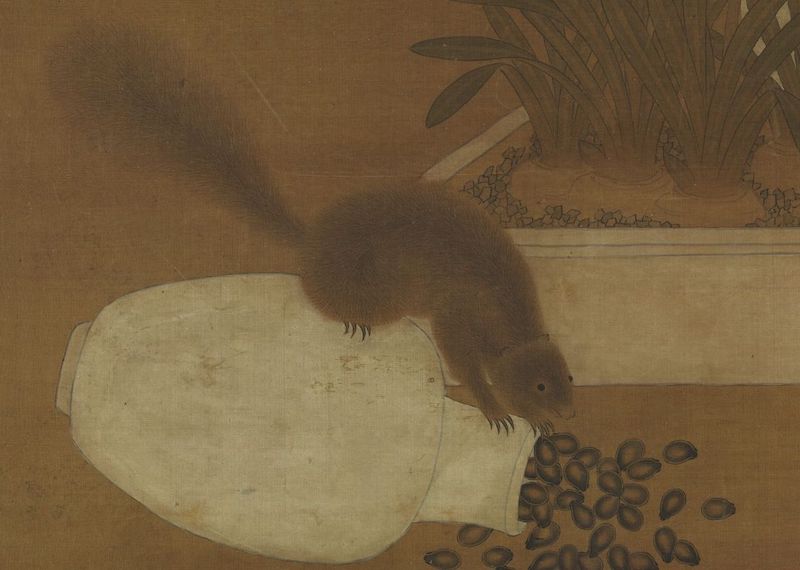
Axis of Years and Dynasties of the Yuan Dynasty (partial) Collection of the National Palace Museum, Taipei
This unnamed painting uses a combination of various auspicious objects to paint squirrels or it was made for the Year of the Rat. The overall composition and layout of the painting is similar to the "Qianlong Kesi Sui Chao Tu" in the Qing Dynasty.
Axis of the Ming and Shang Dynasties
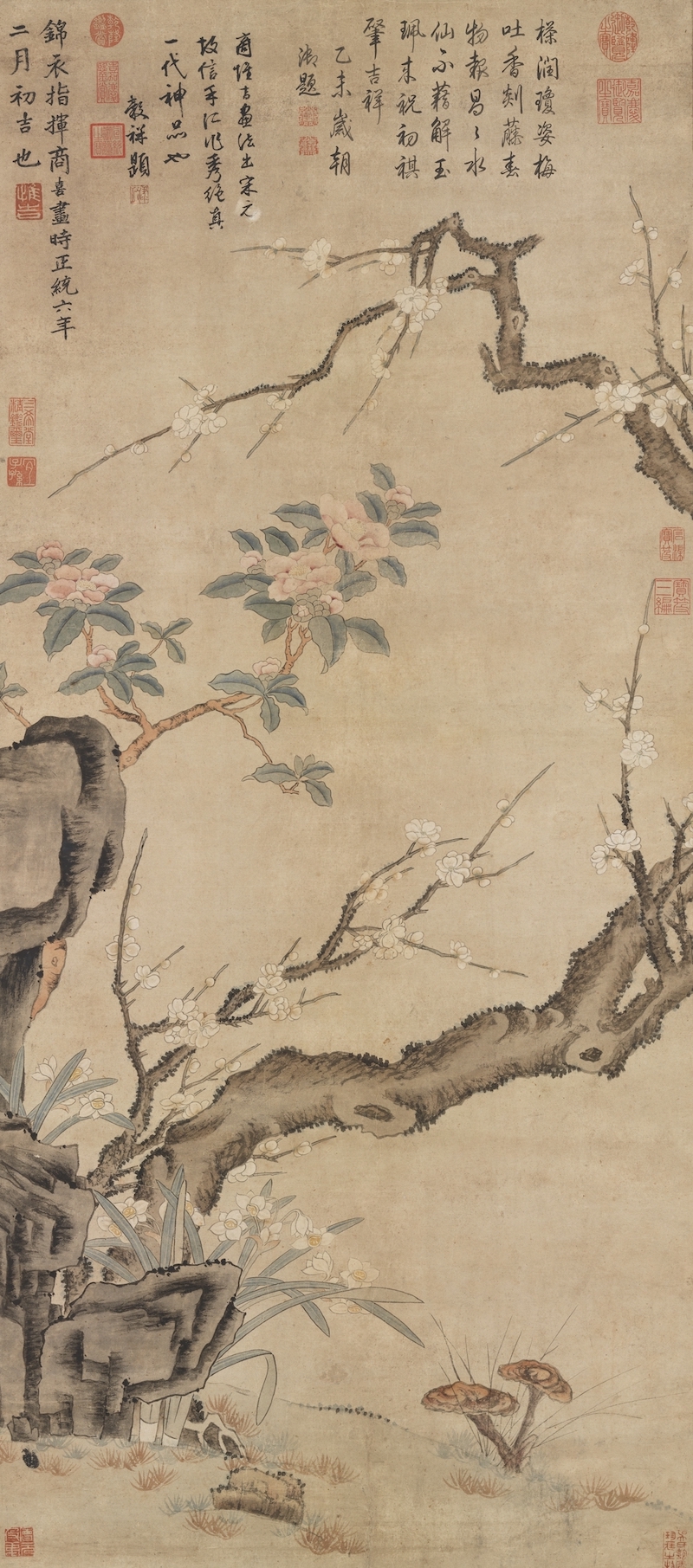
Axis of the Ming and Shang Dynasties Collection of the National Palace Museum, Taipei
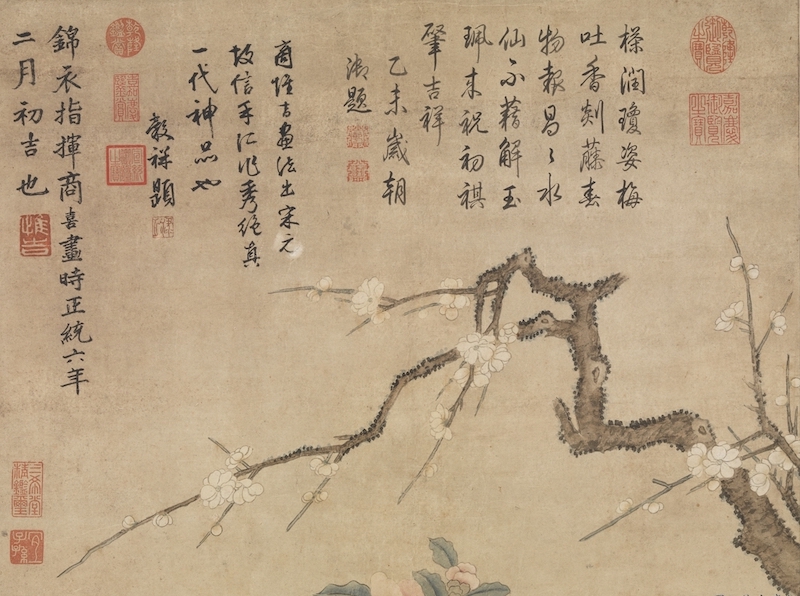
Axis of the Ming and Shang Dynasties (partial) Collection of the National Palace Museum, Taipei
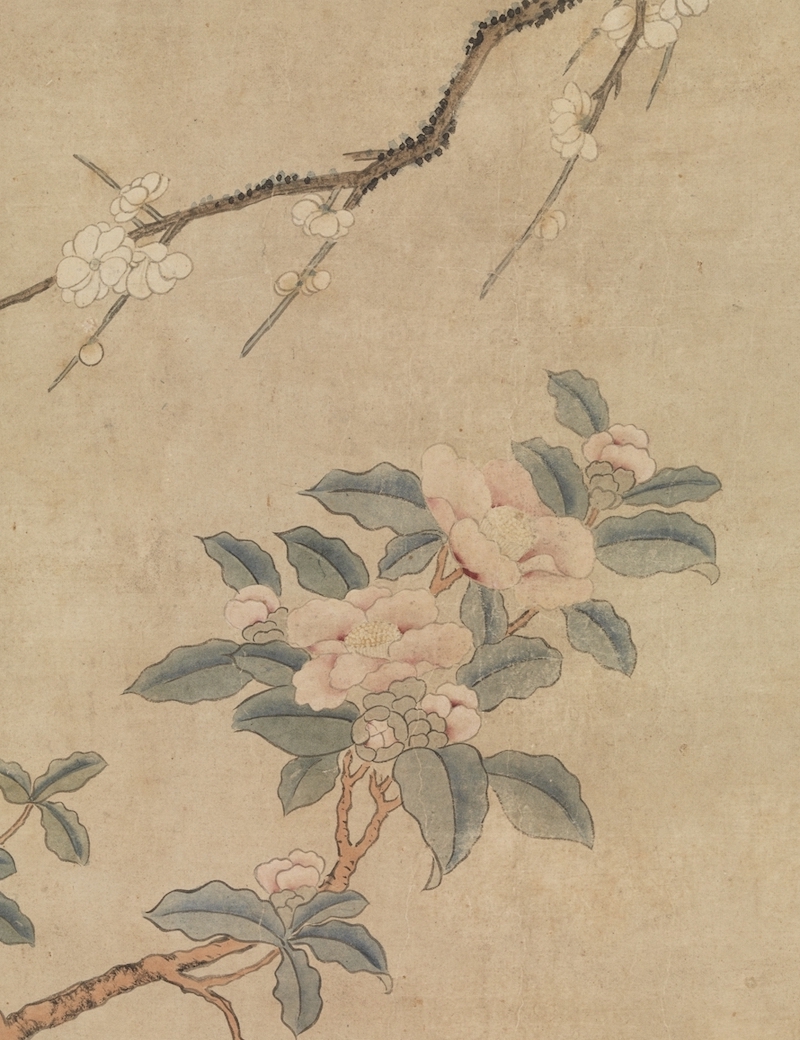
Axis of the Ming and Shang Dynasties (partial) Collection of the National Palace Museum, Taipei
Shang Xi (fifteenth century AD), courtesy name Weiji, was born in Puyang, Shandong, and his date of birth and death is unknown. The landscapes, figures, flowers and birds all imitate the brushwork of the Song Dynasty, all of which are exquisite. In this painting, camellias, plum blossoms, narcissus, and zhicao grow next to fist stones. Huangzhi, pink tea, white plum, vermilion grass, bluestone, colorful and unique among the flowers of Sui Dynasty.
Ming Bian Wenjin Sui Dynasty Chart Axis

Ming Bian Wenjin Sui Dynasty Map Axis Collection of the National Palace Museum, Taipei
Bian Jingzhao (approximately active in 1356-1428), courtesy name Wenjin, was born in Shaxian County, Fujian Province, and his ancestral home was in Longxi, Gansu Province. The Bian family is good at painting flowers, fruits, feathers, and birds. He first served in the Hall of Renzhi in the Yongle Dynasty, and was awarded the position of waiting for the imperial edict in the Hall of Martial Arts in the Xuandejian.
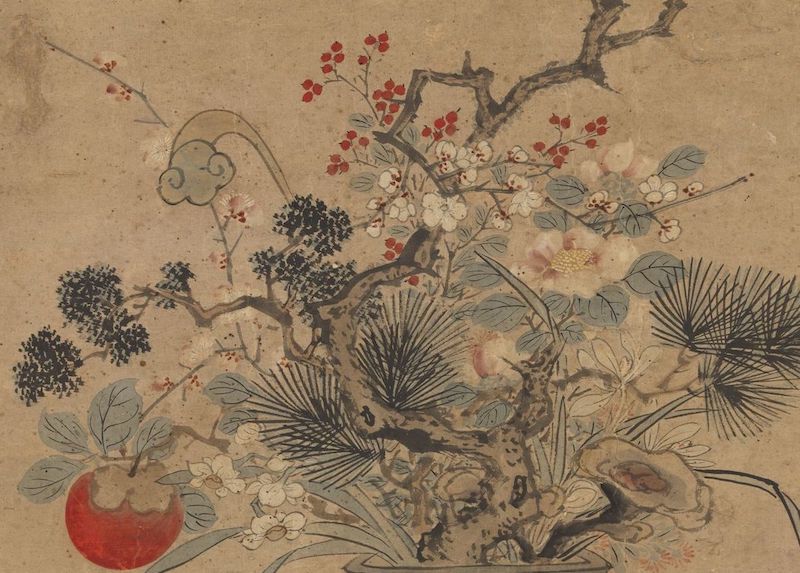
Axis of Wenjin Sui Dynasty in the Ming Dynasty (partial) Collection of National Palace Museum, Taipei
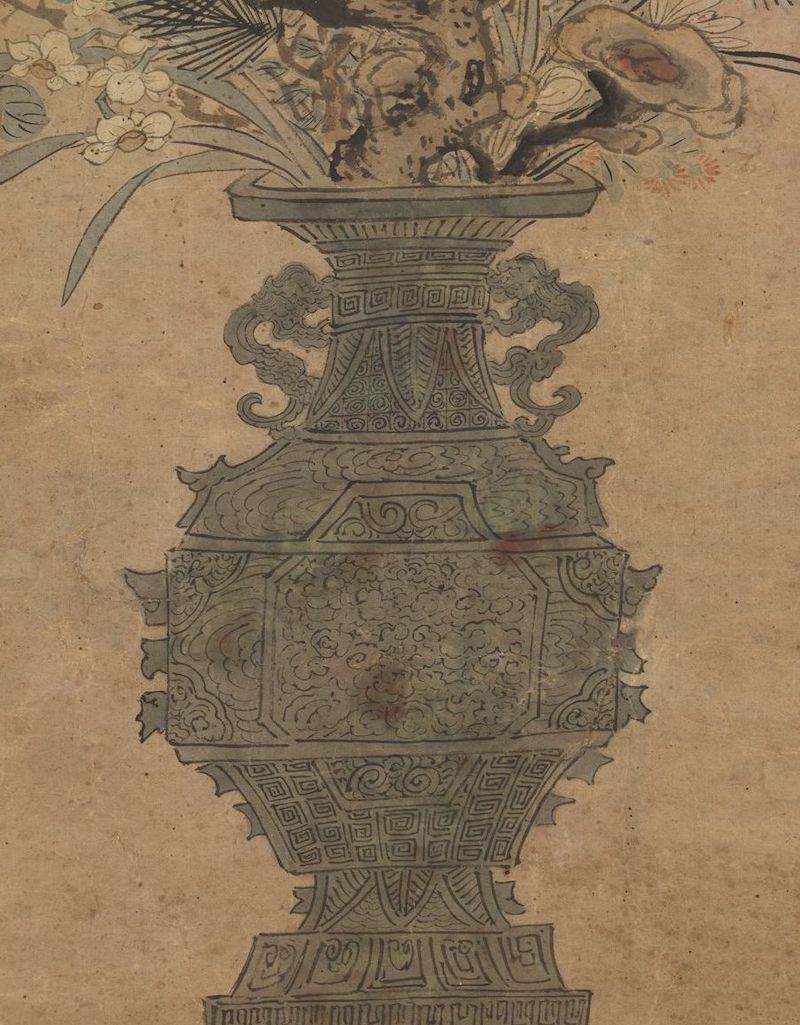
Axis of Wenjin Sui Dynasty in the Ming Dynasty (partial) Collection of National Palace Museum, Taipei
This picture was signed in the second year of Xuande (1472). It is a neutral flower style in the hall. The flowers include pine, cypress, plum, orchid, camellia, narcissus, ganoderma, Tianzhu, persimmon, and wishful thinking. It has the meaning of perfection. The flower vessel is copper. pot. The center of gravity of the whole vase of flowers forms a semicircle in the lower half, and the prunes on it lead to the high and far space, corresponding to the virtual and the real. However, his pen and ink are different from those of Bian's, and the characters were added by later generations.
Axis of Chen Hongshou's Years and Dynasties in Ming Dynasty

Axis of Chen Hongshou's Years in the Ming Dynasty Collection of the National Palace Museum, Taipei
Inscription and postscript in regular script of Emperor Renzong of Qing Dynasty: Mu Defu Qunzhi. The youth is gorgeous and young. All the heroes are full of beauty. Famous flowers spread all over Yangxin. Juxiu painted Qiongji. Lianhuican vase. Flowers and phoenix tubes. Fragrance and color Huanchun screen. Jiaqing Ding Chou's new imperial title.
Axis of Lu Zhi Sui Dynasty in Ming Dynasty

Axis of Luzhi Years and Dynasties in the Ming Dynasty Collection of the National Palace Museum, Taipei

Axis of Lu Zhi Sui Dynasty in Ming Dynasty (partial) Collection of National Palace Museum, Taipei
Cui Zizhong's running script inscription and postscript: Dongfeng gradually greens Yingzhou grass, Caishengdu cuts five-color silk. Today, I am happy to combine the joys and write a poem on the Huanhua River. Cui Zizhong.
Axis of Ming Tao Chengsui Dynasty
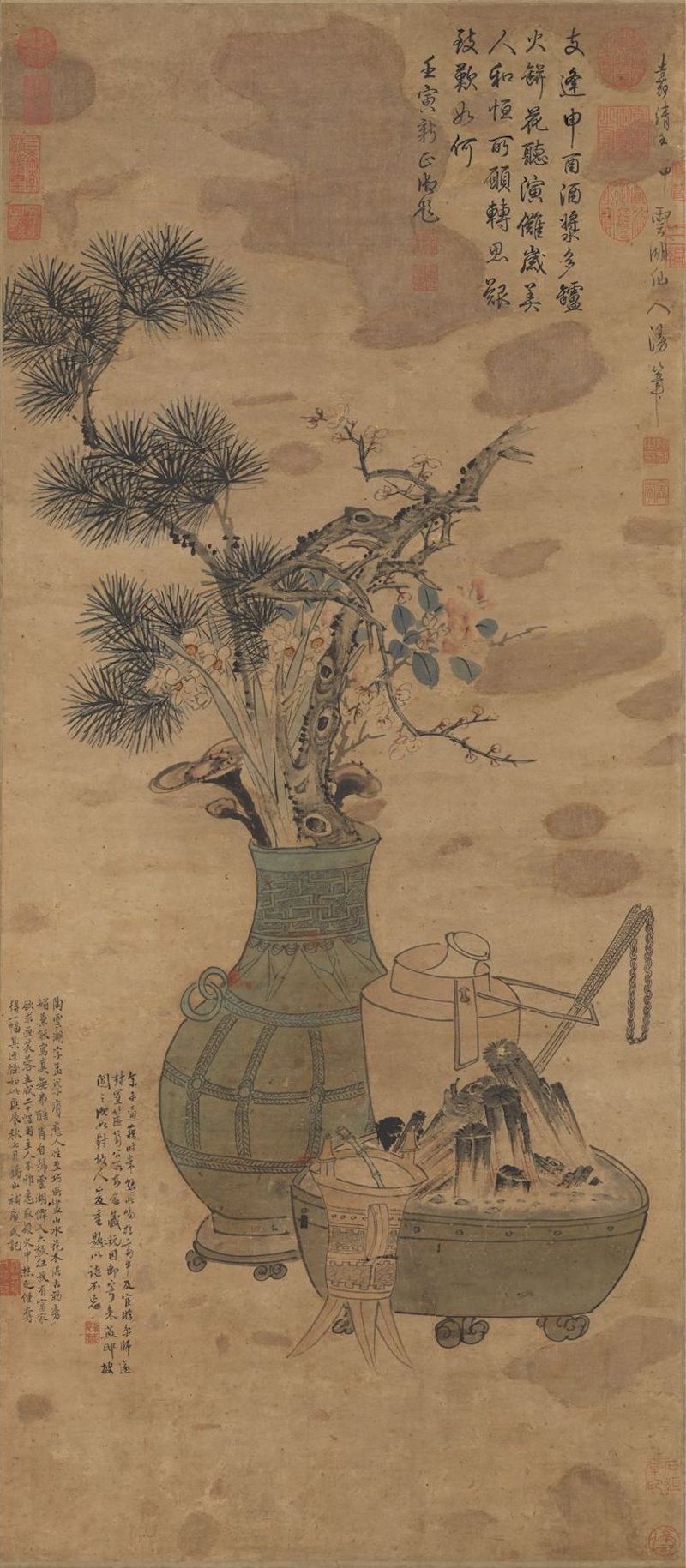
Axis of Ming Tao's Cheng Sui Dynasty in the National Palace Museum, Taipei
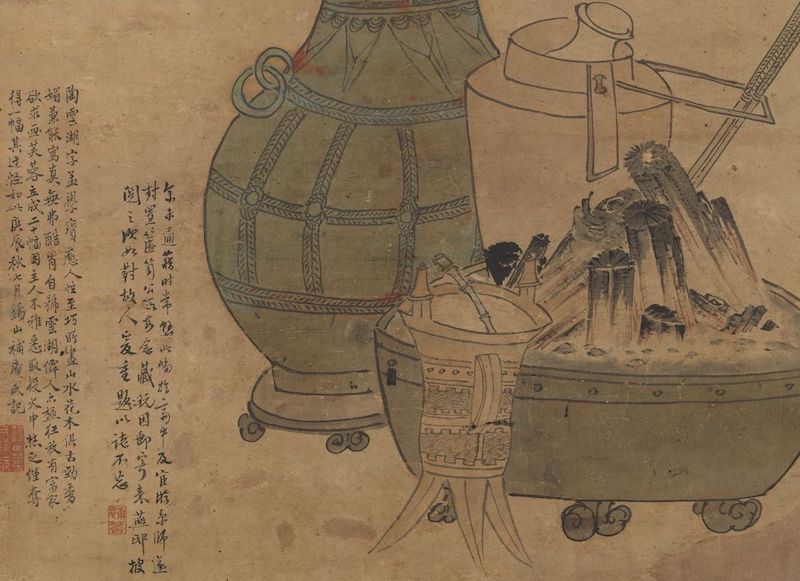
Axis of Chengsui Dynasty of Ming Tao (partial) Collection of National Palace Museum, Taipei
The inscription and postscript of Qing Emperor Gaozong's running script: Zhifeng Shenyou has a lot of wine. The fire bottle flower listens to the Nuo performance. The year-old beauty and Heng wished. How about turning around and sighing. Renyin (1782 AD) Xinzheng imperial inscription.
Axis of Qing Hong Dynasty's Sui Dynasty

Axis of Qing Hong Dynasty's Years and Dynasties Collection of the Palace Museum
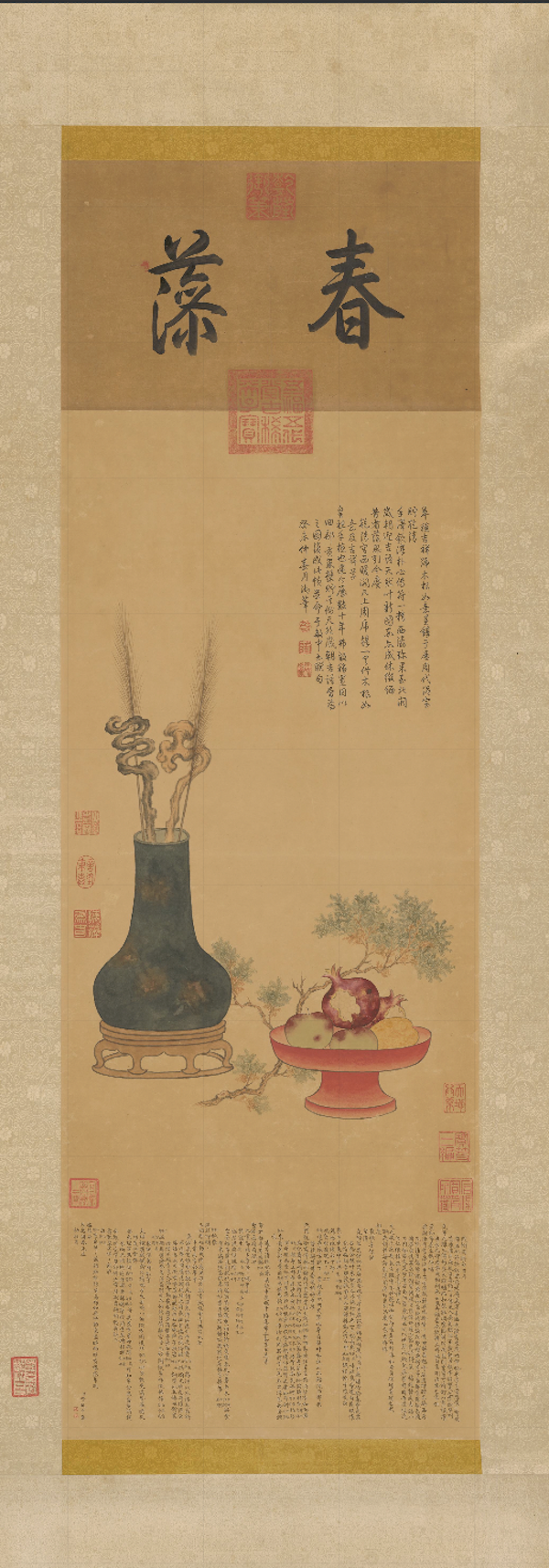
Qing Hong’s Dynasty Pictures and Xinzheng Chonghua Palace Poetry Axis Collection of the Palace Museum
Aixinjueluo Hongli (September 25, 1711-February 7, 1799), the sixth emperor of the Qing Dynasty and the fourth emperor after the capital was established in Beijing. The year name "Qianlong" means "heavenly prosperity". He reigned for 60 years, and continued to practice politics after the Zen throne. He actually exercised the highest power for 63 years and four months.
Qing Yongrong Ping An Ruyi Axis
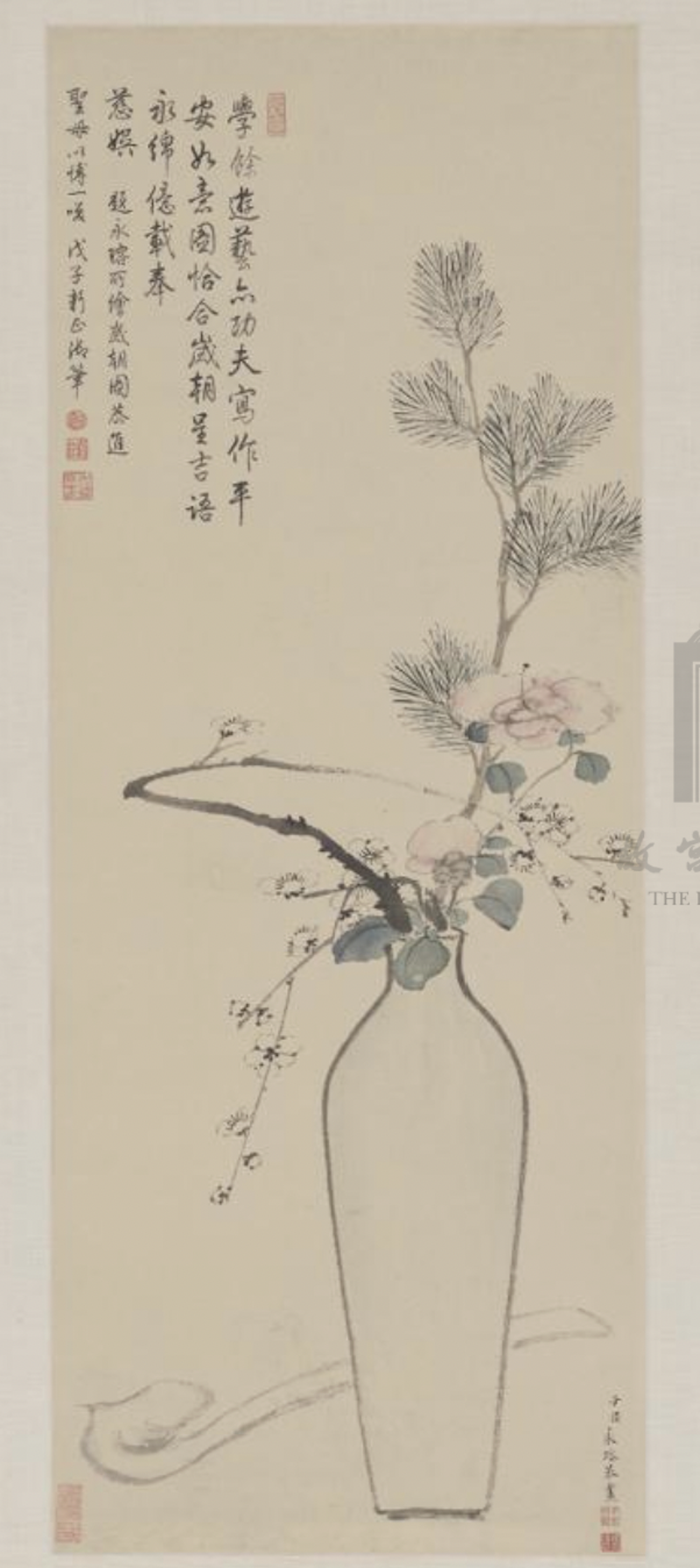
Qing Yong Rong Ping An Ruyi Axis Collection of the Palace Museum
This painting is self-titled "Painting of Zichen Yongrong Gong", with a seal of "Zichen Yongrong" in Zhu Wenyin and "Suye Zigong" in Bai Wenyin. "Recreation after school is also kung fu, and writing is safe as intended. It fits the auspicious language of the old dynasty, and it will last for hundreds of millions of years to be kind and entertaining. The picture of the old dynasty drawn by Yong Rong respectfully enters the Virgin Mary, so as to make a smile. Wuzi Xinzheng Yubi", The seal is "Qian" Zhu Wenyin, "Long" Zhu Wenyin, "everything is in the same spring" Zhu Wenyin, and "chatting to see business" Bai Wenyin. In addition, Zhu Wenyin, "Minister Pang Yuanji Gongzang".
This picture depicts pine branches, plum blossoms, etc. inserted in a vase, with a Chen Ruyi handle underneath. The color is light and the layout is simple, which is quite literati. Yongrong uses vases and Ruyi as a metaphor for the auspicious meaning of "peace and wishfulness", while pine branches and plum blossoms express the wish of longevity. In the thirty-third year of Qianlong's reign (1768), Emperor Qianlong dedicated one of the seven poems in the first lunar month, and dedicated this picture to the Empress Dowager Chongqing, conveying his filial piety and blessings to his mother.
Zou Yigui Sui Dynasty Picture Axis in Qing Dynasty
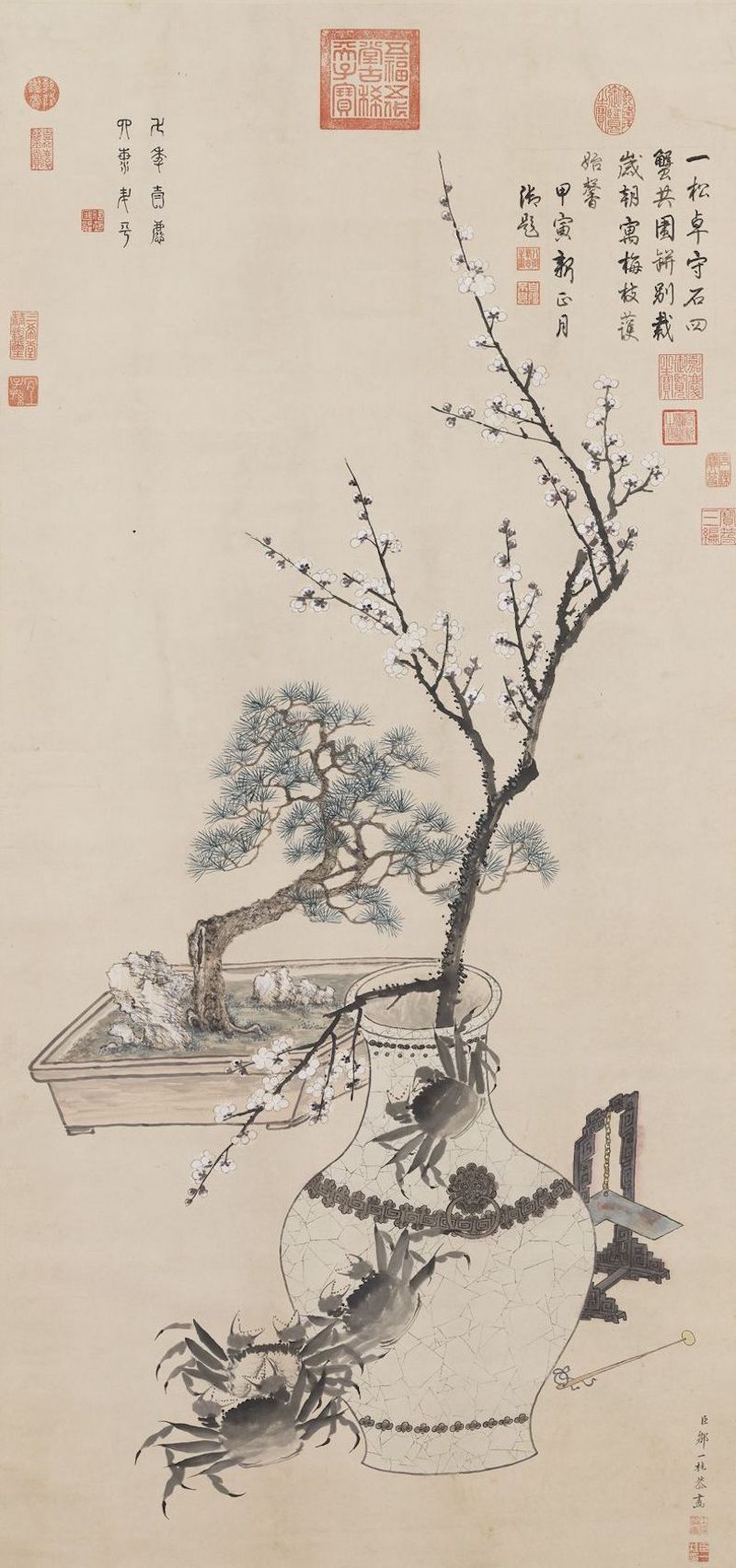
Zou Yigui Sui Dynasty Picture Axis in the Collection of the National Palace Museum, Taipei
Zou Yigui, born in the twenty-fifth year of Kangxi (1686) and died in the thirty-seventh year of Qianlong (1772), was born in Wuxi, Jiangsu Province. In the fifth year of Yongzheng, he was a Jinshi, an official to the Minister of the Ministry of Rites, and was added the title of Minister. He is the author of Xiaoshan Huapu. The small mountain painting was originally produced by Yun Shouping. However, most of the works are made according to the rules, so the brushwork is neat and the coloring is bright. This painting has evergreen potted pines and jade chimes, implying auspiciousness for ten thousand years. There are also plum vases and four crabs that rise up from the vases, which are homophonic for "the four seas rise to peace".
Qing Dynasty Jiang Tingxi's painting scroll of Sui Dynasty
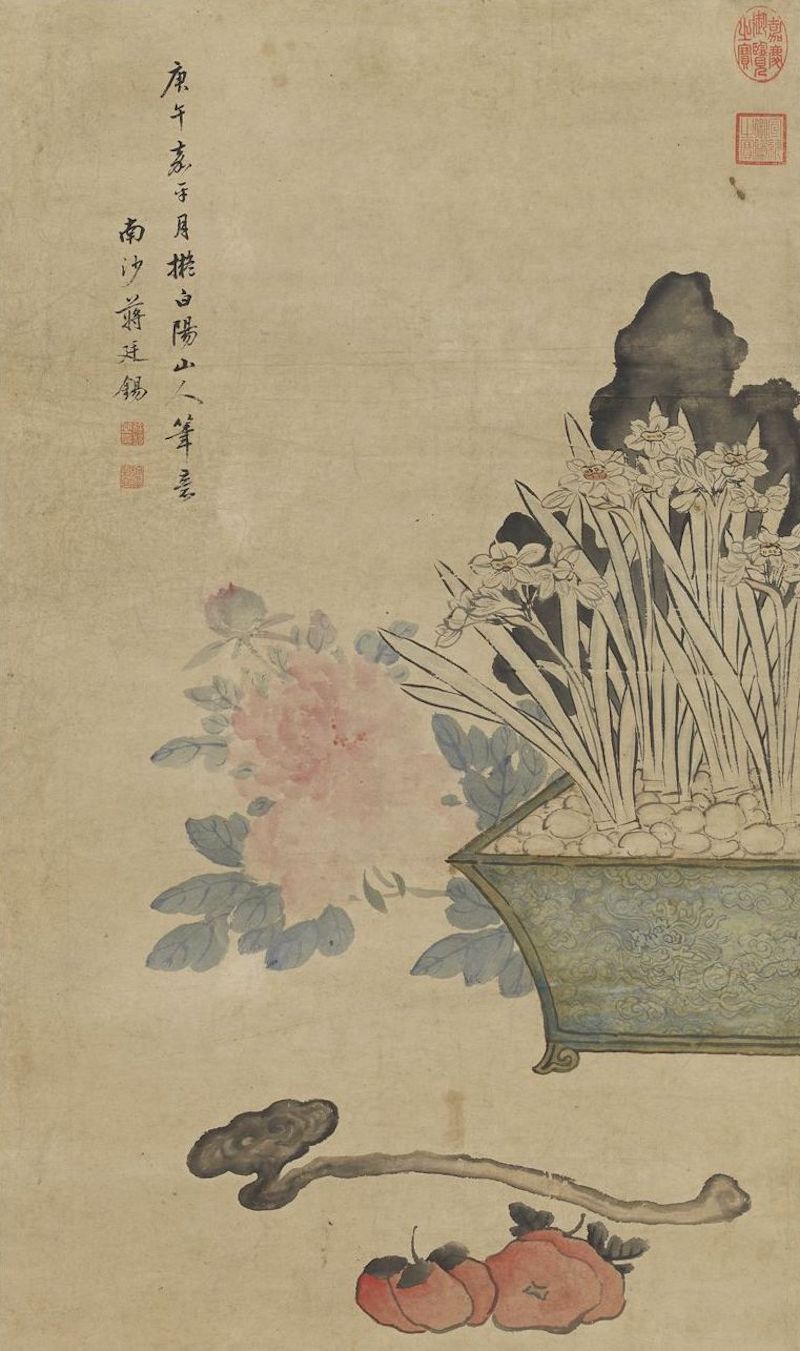
Qing Dynasty Jiang Tingxi Painting Years and Dynasties Axis Collection of the National Palace Museum, Taipei
Jiang Tingxi (1669-1732), a native of Changshu, Jiangsu. The word Yangsun, the word Youjun, and the names Xigu and Nansha. Liguan Wenhuadian University Bachelor, has a political voice, traveled with Gu Xuepo when he was young, and was good at sketching. After becoming an official in the court, he was dignified and conscientious, and occasionally he was one or two, and was treasured by the palace ban, with very few authentic traces. The works of Nansha seen in the palace are rich and colorful.

Qing Dynasty Jiang Tingxi's painting scroll (partial) in the collection of the National Palace Museum, Taipei
This frame was completed at the age of twenty-two, elegant and unconventional, better than his later years.
Chen Shu Sui Dynasty Lijing Axis in Qing Dynasty
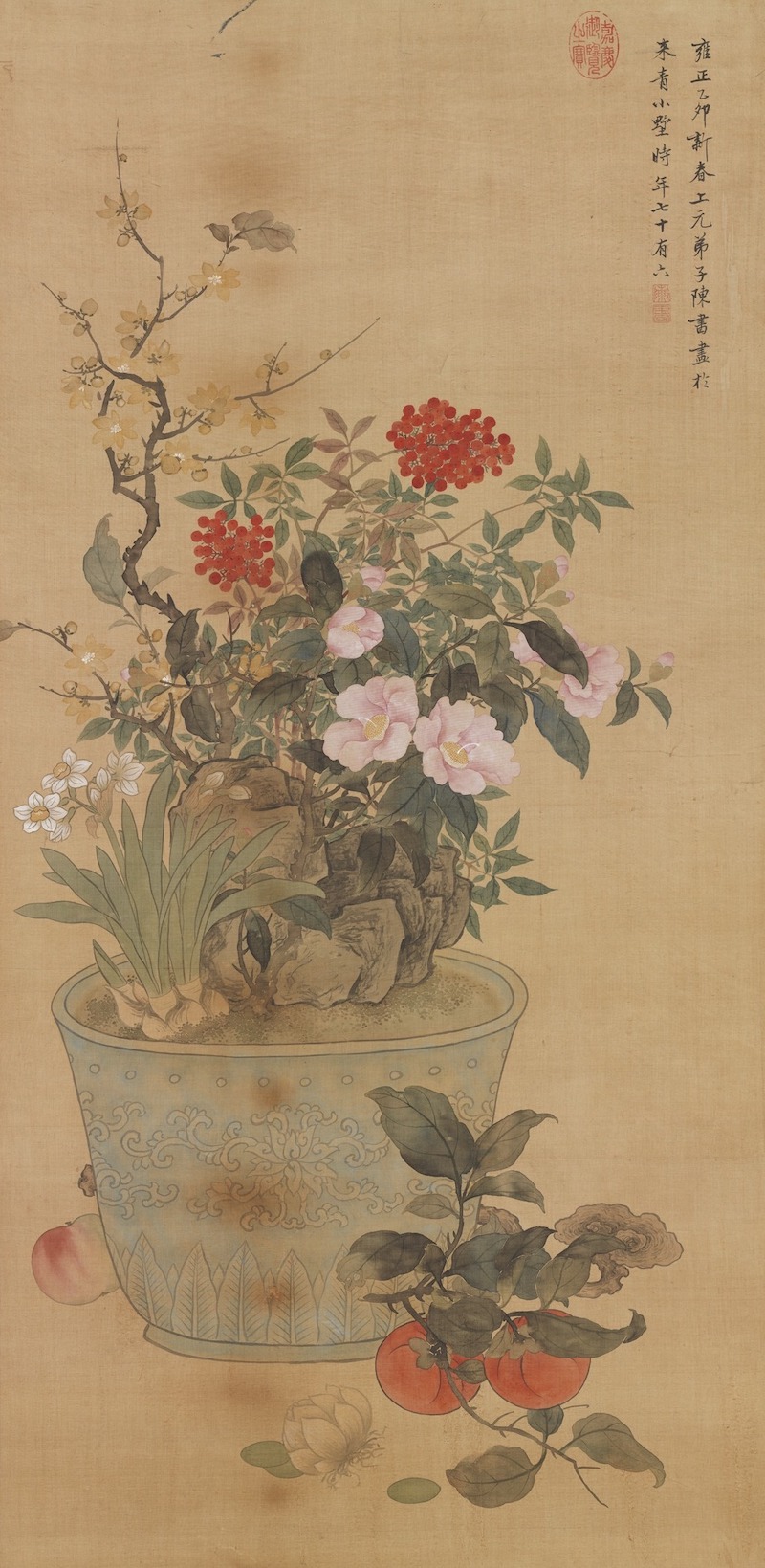
Qing Dynasty Chen Shu Suidao Lijing Axis Collection of the National Palace Museum, Taipei
Chen Shu (1660-1736), courtesy name Nanlou, nicknamed Shangyuan Disciple, Fu'an, and late Nanlou Old Man. People from Jiaxing, Zhejiang. Good at flowers, birds, grass and insects, as well as landscape figures, this axis was made at the age of seventy-six. This picture is a sketch of flowers offered during the New Year's Lantern Festival by Yongzheng Yimao (1735). The bonsai in the painting moves several kinds of flower plants into porcelain pots, and plants them alternately according to the proportion of height and color characteristics, which is the perfect combination of flower arrangement and bonsai art. Adding narcissus and Tianzhu to Shibiao Shou, it is "Heavenly Immortal Gongshou"; next to it are lilies, persimmons, ganoderma lucidum, and apples, and it also has the meaning of "everything goes well" and "peace and happiness".
Axis of Ren Yi Sui Dynasty in Qing Dynasty

Axis of Ren Yi Sui Dynasty in the Qing Dynasty Collection of the Palace Museum
Ren Yi (1840-1896), originally named Run, styled Xiaolou and Bonian, was born in Shaoxing, Zhejiang, and lived in Shanghai, selling paintings for a living. Good at figures, portraits, flowers and birds, landscape painting. In addition to inheriting folk and traditional literati paintings, and integrating the strengths of Chen Hongshou, Chen Chun, and Xu Wei, his paintings also absorbed Western painting sketches and coloring methods to form a colorful, novel and vivid unique style of painting, which has an artistic taste that appeals to both refined and popular tastes and a distinct flavor of the times. Together with Ren Xiong, Ren Xun and Ren Yu, they are called the "Four Rens at Sea".
Axis of Wu Changshuo's Sui Dynasty in the Qing Dynasty

Axis of Wu Changshuo's Contribution to the Qing Dynasty in the Qing Dynasty Collection of the Palace Museum
Suizhao refers to the Lunar New Year's Day. Painters of all dynasties, especially literati painters, like to draw "Sui Chaoqing Contribution Map" on this day as the first work at the beginning of the new year. As a literati painter, Wu Changshuo also painted "Sui Chao Qing Gong Tu" almost every year, and it changed a lot. Its biggest feature is that it rarely draws materials from peonies. There is a passage in his "Fou Lu Bie Cun" that discloses its Intention, the text said: "Ji Ugly New Year's Eve, behind closed doors to watch the year, and Dong Dong paints for self-entertainment. Every year, most of the pictures of the dynasty are painted with peonies, which are named after wealth and honor. If you live in the sea, an official is like a louse, and the rich and noble flowers must not be commensurate, so When I write about plums, I have the appearance of being born in the world, when I write about chrysanthemums, I have the bones of proud frost, and when I write about chrysanthemums, I have the bones of frost. There is still no image of peonies in "Photo Courtesy of the Qing Dynasty". At that time, Wu's life had been greatly improved, but he still did not paint peonies, which shows that his noble personality and paintings do not change his original intention of wealth.
This picture is composed of vase plums, narcissus, cattail grass, and beautiful stones, and placed in vases and other utensils to show that it is a clear offering on the desk. The items are arranged in the picture in a high and low, patchwork manner, and are arranged in a diagonal form with the right high and the left low. The upper left corner and the lower right corner are respectively equipped with inscriptions and seals. This is a common composition form in Wu Changshuo's flower paintings. In the upper left corner of the screen, there is a self-titled title: "Suichao Qing offering. Suichao writes flowers on the desk, just like the ancients wrote about the movement and flow of things during the year. I hereby imitate the meaning. Yimao Suihan Wu Changshuo."
This picture is swayed casually, and the true feelings overflow from the pen. A branch of red plum in a high-necked ancient vase, as well as emerald green narcissus, and scattered cattail grass, all have the same meaning, and the brushwork is meaningful and free, with a very elegant and elegant atmosphere. The use of ink and color is also just right, the ink is suitable for thick and light, and the color is pretty and bright, which combines elegance and beauty. The double-hooked daffodils also reflect the unique charm of Wu's strong and simple brushwork in his later years.
(This article is compiled from relevant materials of the Palace Museum and Taipei Palace Museum.)
